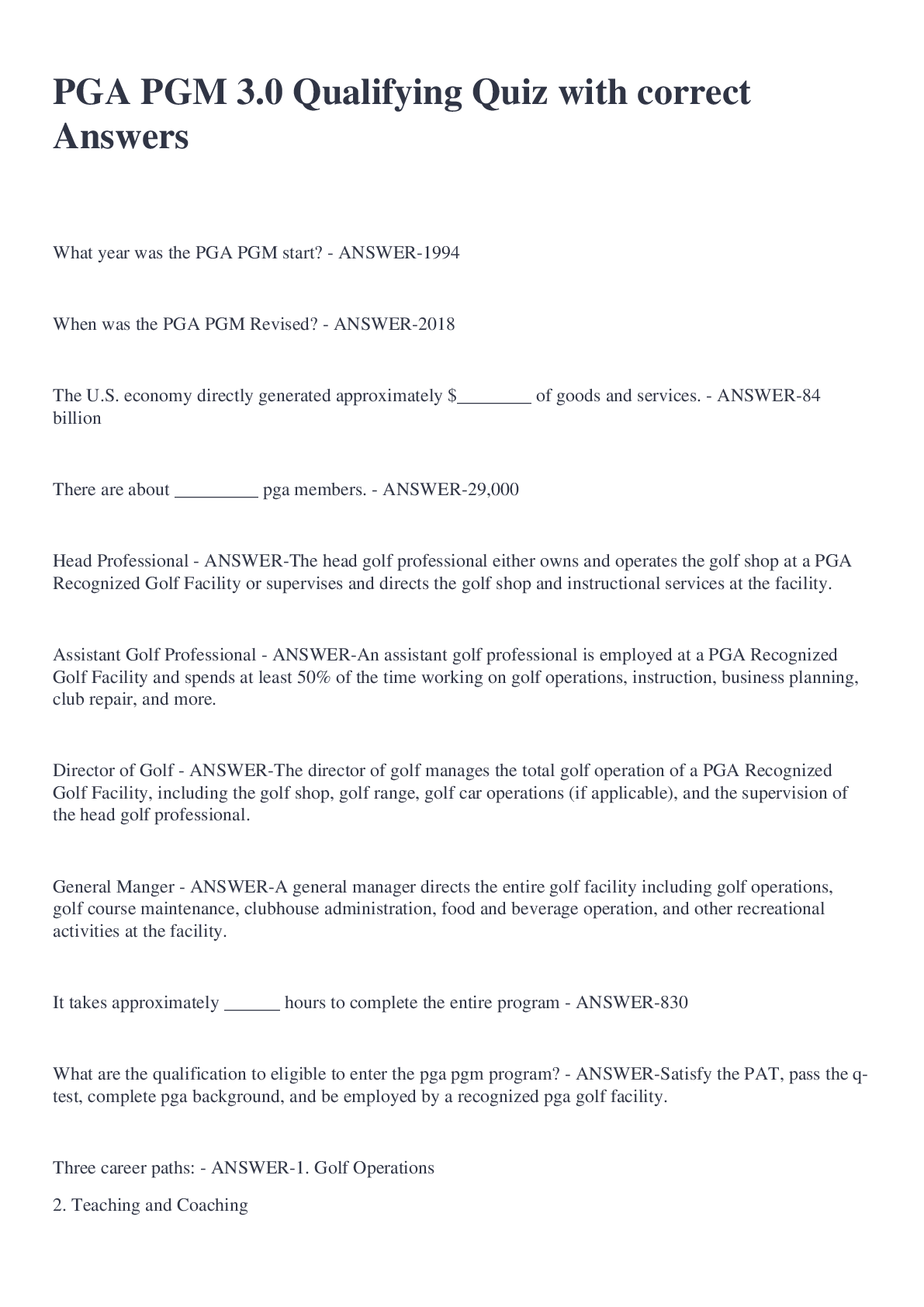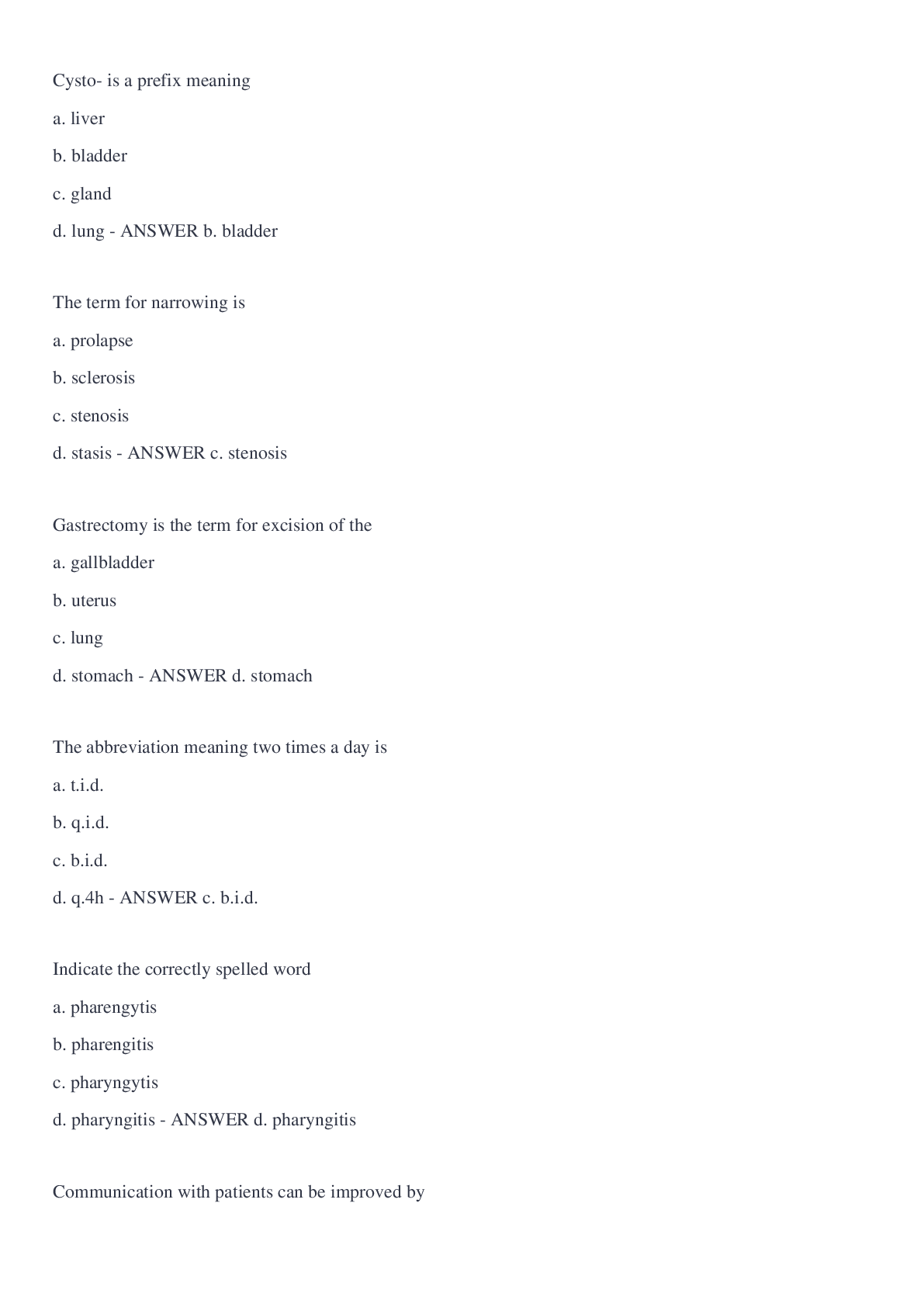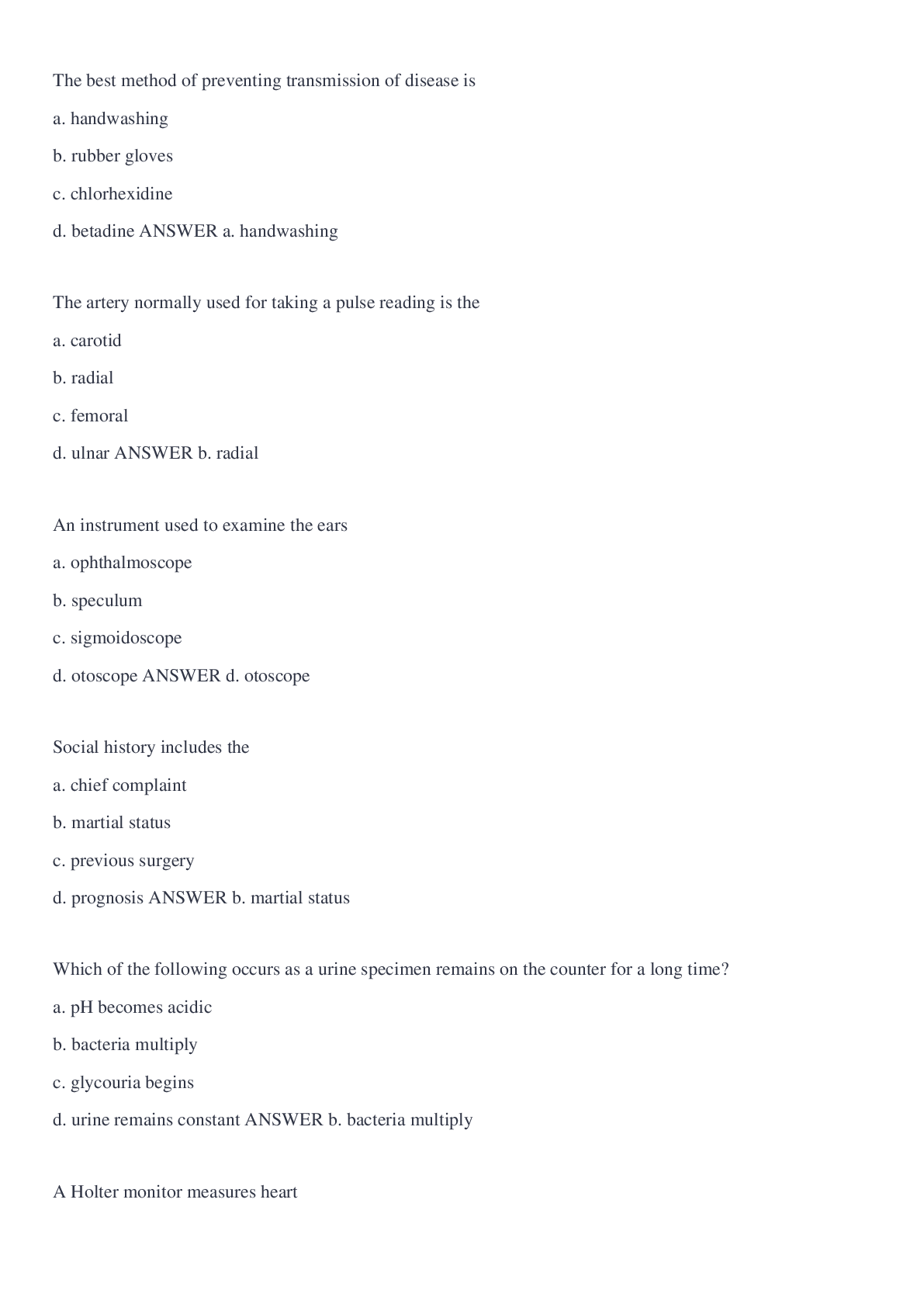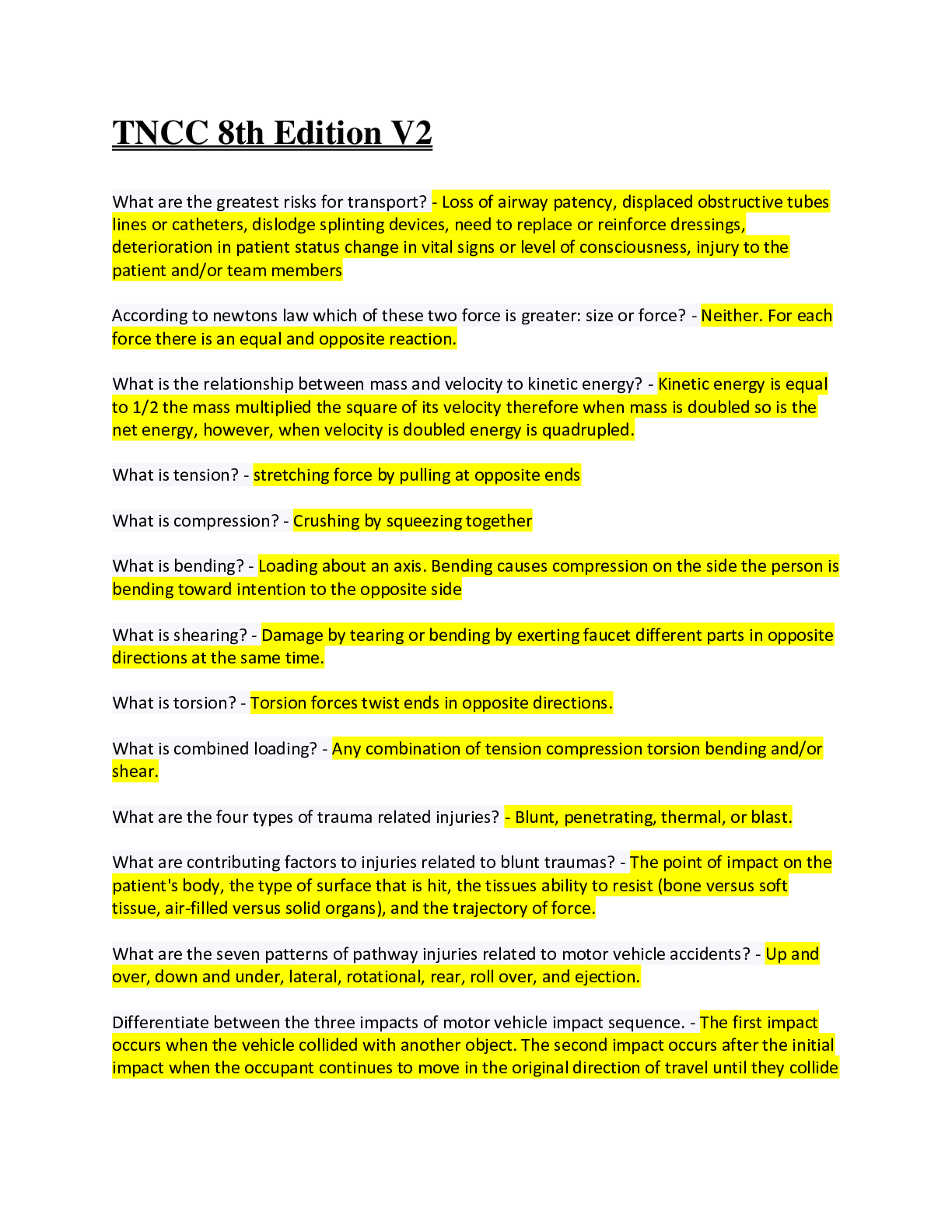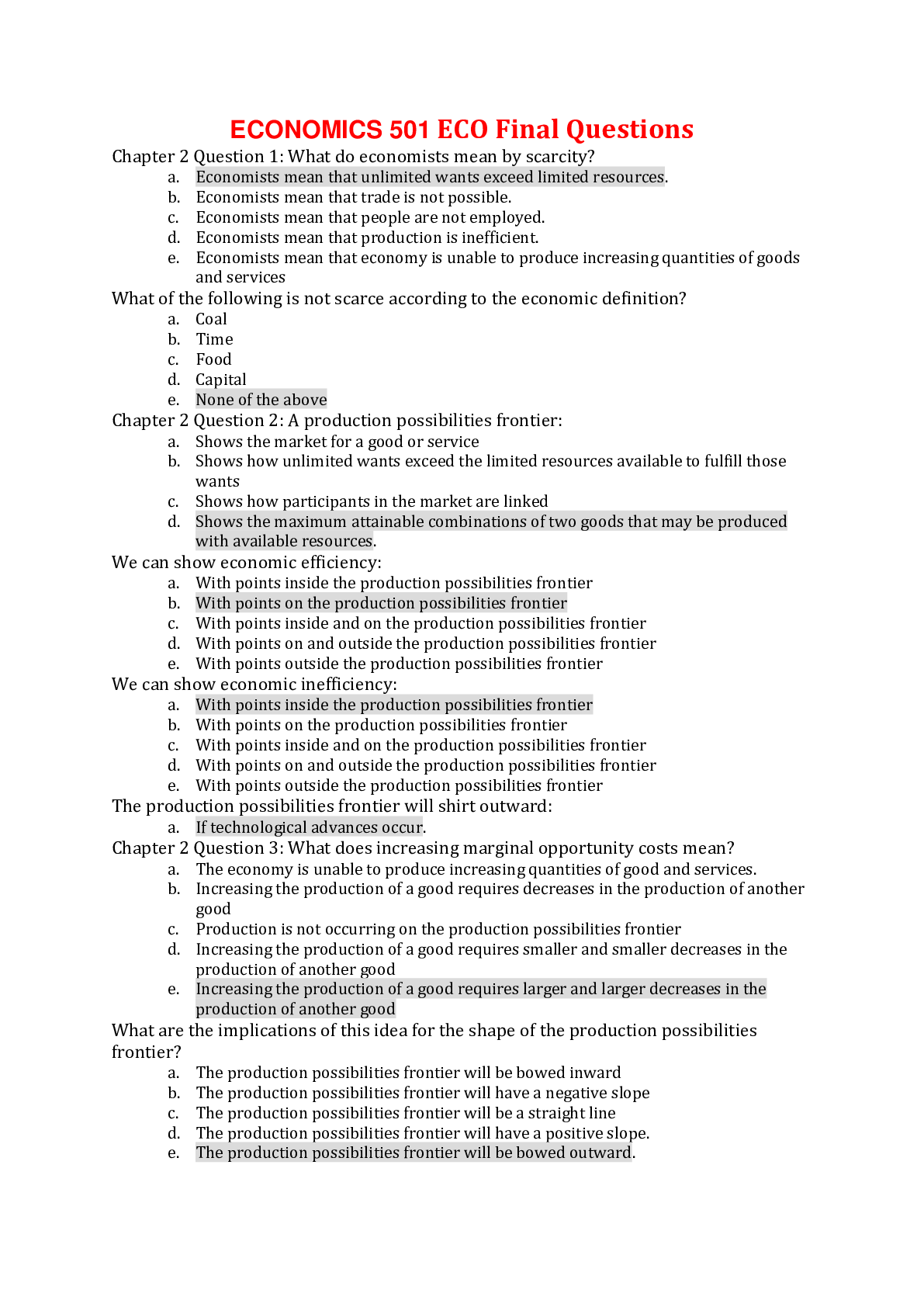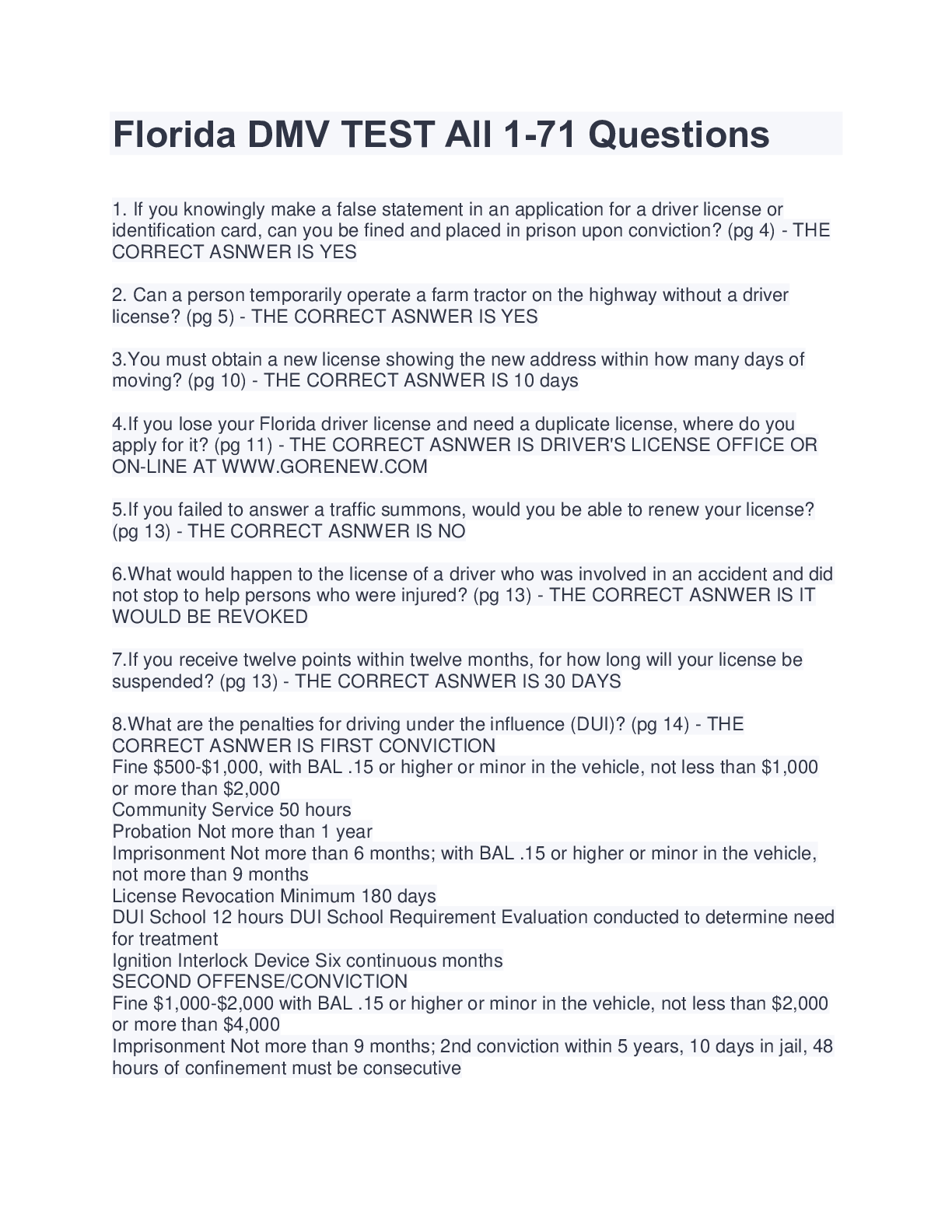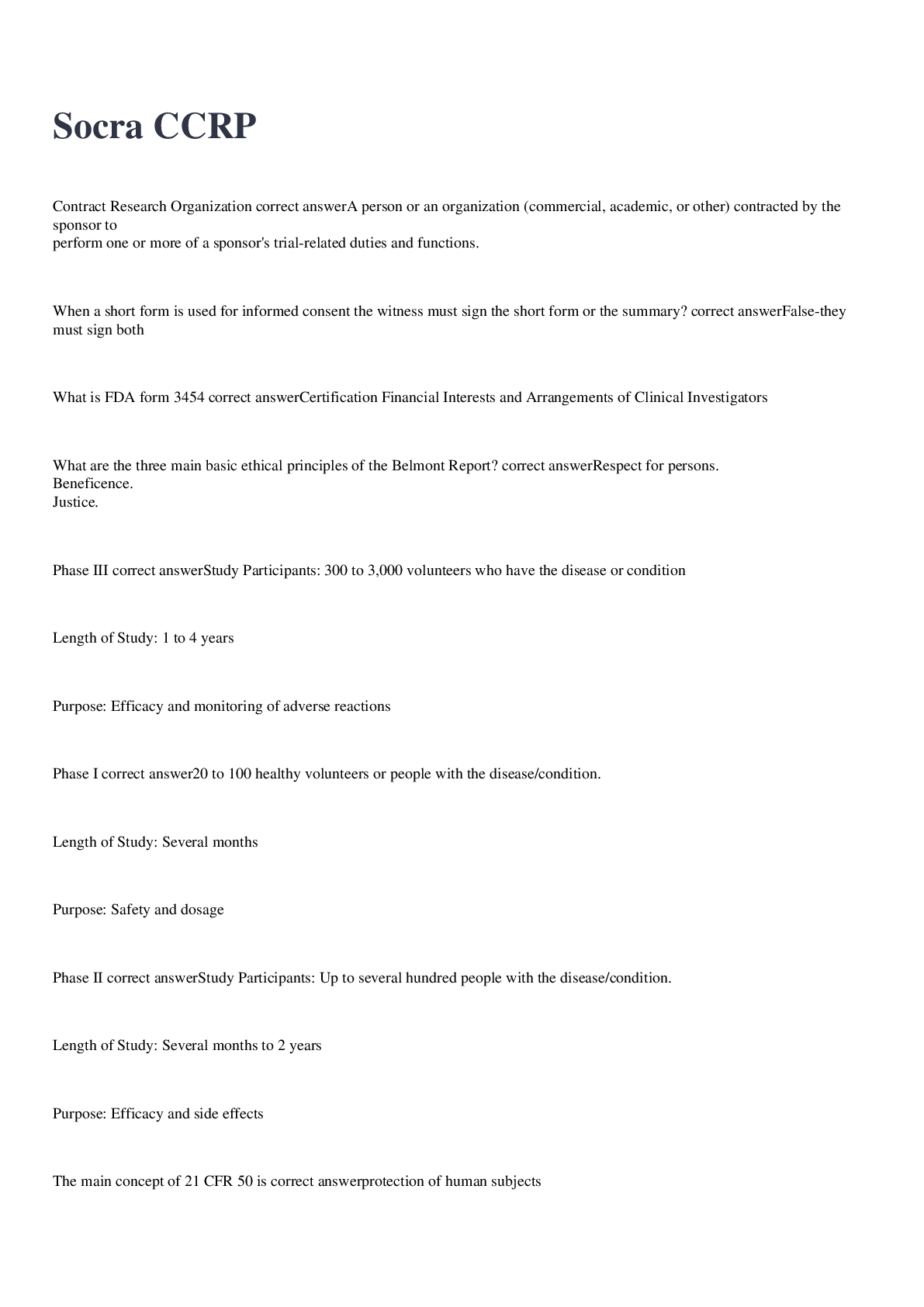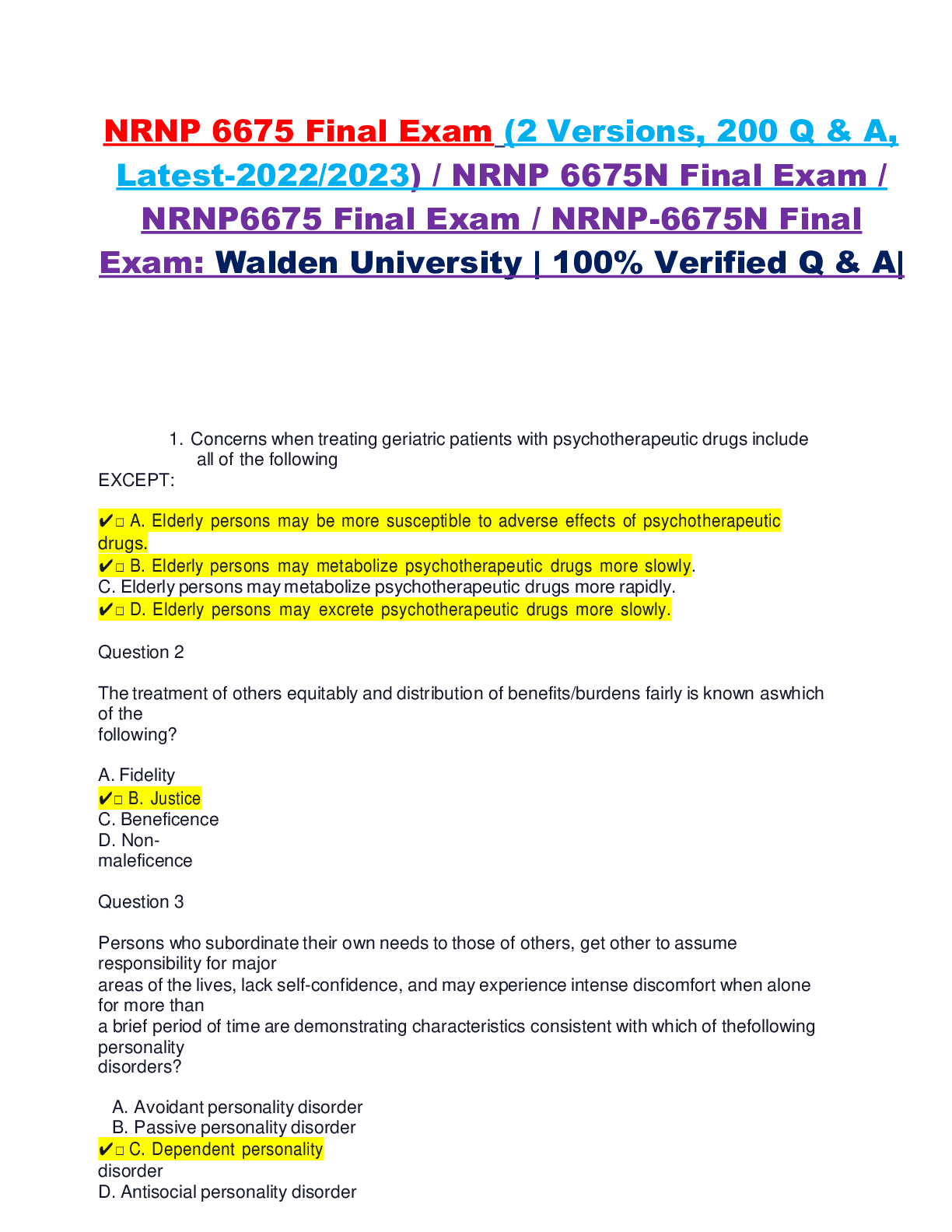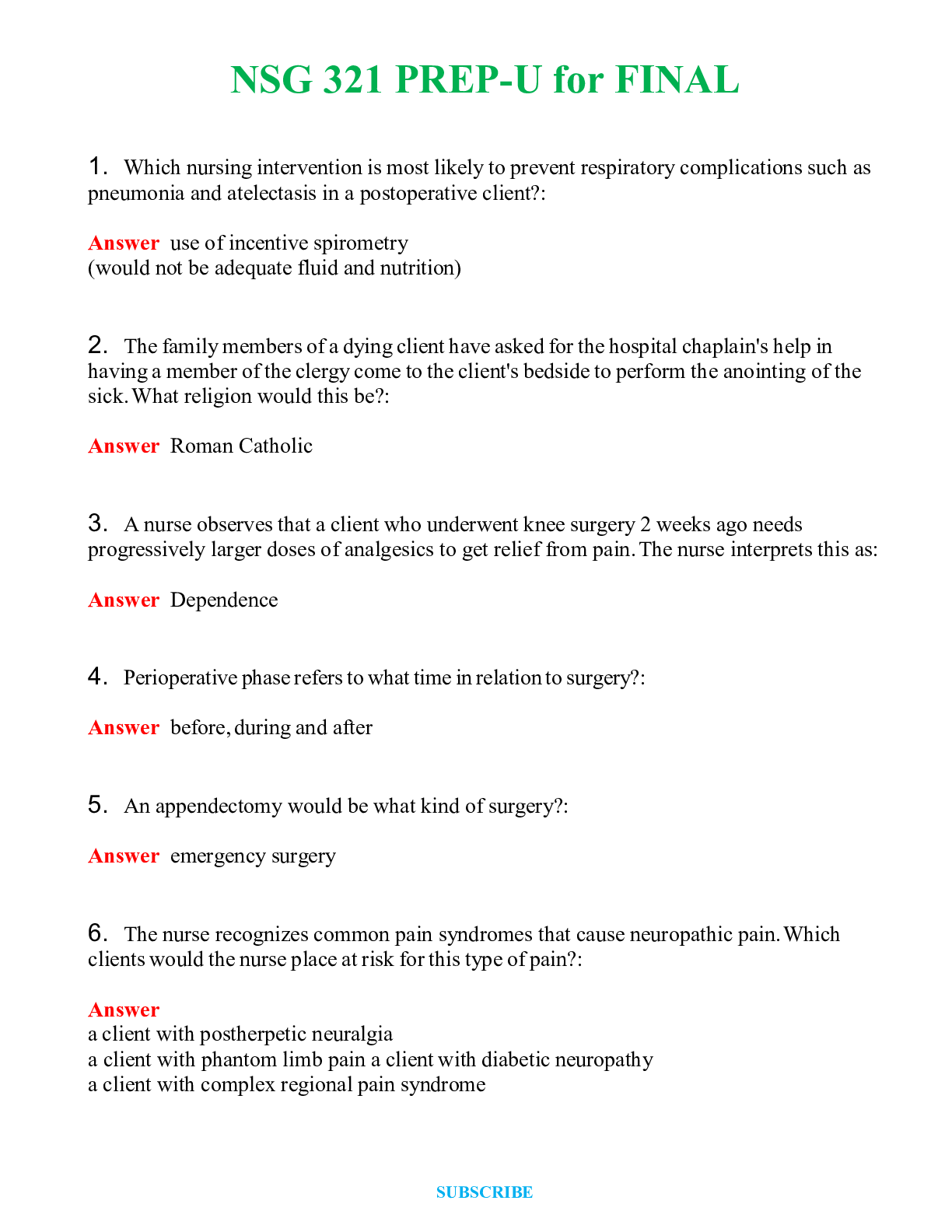WGU Global Business 2022 Questions and Answers
Document Content and Description Below
5 Characteristics of globalization - ANSWER 1. Remove trade barriers (economic) 2. Culture (social) 3. IT (social) 4. Investment (economic) 5. Political system (political) Benefits of globaliza... tion - ANSWER -sharing resources -more choices for consumers -creates jobs in developing countries -raises living standards International Monetary Fund (IMF) - ANSWER Focuses on transactions Determines exchange rates provides short term emergency loans/funding promotes monetary policies in countries World Bank - ANSWER -long-term loans to countries for economic development, trade promotion, and debt consolidation. -helps develop partnerships World Trade Organization (WTO) - ANSWER -promotes international trade -settles international trade disputes -tariff negotiations -provides technical assistance to emerging countries Global Digital Divide - ANSWER the gap in access to information and communication technologies between the wealthy and poor regions of the world Mercantilism - ANSWER An economic policy under which nations seek to increase their wealth and power by exporting more than importing absolute advantage - ANSWER the ability of an individual, a firm, or a country to produce more of a good or service than competitors, using the same amount of resources comparative advantage - ANSWER the ability of an individual, a firm, or a country to produce a good or service at a lower opportunity cost than competitors H-O Theorem - ANSWER a nation will EXPORT goods whose production requires intensive use of the nations relatively abundant and cheap factor; and IMPORT the goods who's production requires intensive use of the national relative scarce and expensive factor Factor Price Equalization - ANSWER Prices of factors of productions (such as wages) will eventually equalize across different countries as a result of international trade. Porter's Diamond Model - ANSWER Four determinants of advantage" -factor conditions (elements created for yourself, most important) -demand conditions -related and supporting industries -firm strategy, structure, and rivalry trade policy - ANSWER a government policy that directly influences the quantity of goods and services that a country imports or exports -can be implemented to protect infant industries, sanction a country (tariffs) or for national security Regional Economic Integration - ANSWER Agreements among countries in a geographic region to reduce and ultimately remove tariff and nontariff barriers to the free flow of goods, services, and factors of production between each other Free Trade Area (FTA) - ANSWER A region where member states remove all trade barriers between themselves, but each member state is allowed to keep different barriers against non-member states (barriers do not have to be the same as another country of the agreement) Customs Union (CU) - ANSWER Agreement between two or more (usually neighboring) countries to remove trade barriers between themselves, but to impose identical barriers to non-member states Common market - ANSWER a group of countries that acts as a single market, without trade barriers between member countries. Includes free movement of goods, services and labor between the countries. Must have identical barriers to non-members Economic Union - ANSWER A group of countries committed to (1) removing all barriers to the free flow of goods, services, and factors of production between each other, (2) the adoption of a common currency, (3) the harmonization of tax rates, and (4) the pursuit of a common external trade policy. NAFTA - ANSWER US, Canada, Mexico -Free Trade Agreement ASEAN (Association of Southeast Asian Nations) - ANSWER An international organization linking together the 10 most important countries of Southeast Asia -Common Market Mercosur - ANSWER The largest latin american trade agreement; includes Argentina, Bolivia, Brazil, Chile, Colombia, Ecuador, Paraguay, Peru, and Uruguay European Union (EU) - ANSWER the world's largest common market, composed of 28 European nations Balance of Payment (BOP) - ANSWER --a statement of account that shows all transactions between the residents of one country and the rest of the world for a given period of time Current Account (BOP) - ANSWER Records the value of exports and imports of goods and services of a country in a period of time. A current account surplus exists if the value of exports of goods and services exceeds the value of imports. -includes balances for trades/goods, services, income (stock/bonds), and net transfers (gifts/aid) Financial account (BOP) - ANSWER Shows how the country's current account is financed (investments, etc) spot market - ANSWER market in which a transaction is made immediately at the current price/exchange rate Future Markets - ANSWER the markets in which participants agree today to buy or sell an asset at some future date, locks current exchange rate on date agreement made forward market - ANSWER a mechanism for buying and selling currencies at a preset price for future delivery. same as future market, but more customized to countries involved Resources for learning about other cultures - ANSWER Dept of Commerce Guide Economists Intelligence Unit Culture Grams PWC Doing Business Craigshead International Business Japan business culture - ANSWER -Slight bow and handshake -No direct eye contact -Group oriented goals/work -want to do business with high ranking employee Korea business culture - ANSWER -"Inwa"- Elders get high respect from youth China business culture - ANSWER -The Chinese rarely do business with companies or people they do not know. -focus on relationship between superior and subordinate -like to find someone to benefit them (inside favors, etc) Arabian countries business culture - ANSWER -left hand is unclean -reluctant to do business with women -may divert from topic -don't overly compliment host's possessions (they will feel obligated to give it to you) -don't inquire about family Latin America business culture - ANSWER -not time conscious -like to develop personal relationships -not strict on deadlines Communism - ANSWER Gov't controls all factors of production -classless society (everyone works for gov't) Capitalism - ANSWER an economic and political system in which a country's trade and industry are controlled by private owners for profit, rather than by the state. Socialism - ANSWER -Gov't controls strategic industries (such as medical/education/etc) -able to provide services to public for free micropolitical risk - ANSWER Political risk that affects only specific firms or a specific industry operating within a country macropolitical risk - ANSWER a political risk that essentially affects all businesses in a given country Patent - ANSWER Excludes others from selling/producing invention for a set period of time Copyright - ANSWER applies to authors Trademark - ANSWER a word/phrase/symbol to identify a business social responsibility - ANSWER protect environment, treat employees with respect, keep customer info protected, treating partners fairly Enron Scandal - ANSWER Mark to market -Used expected future profit as currently earned profit, making them seem more successful to investors World Com Scandal - ANSWER Under-reported their costs and overstated their profit Vivendi Scandal - ANSWER Improperly adjusting Accounting reserves to meet earnings Parmalet Scandal - ANSWER Lied about the money it had in the bank account when they actually had debt. Provided a fictional bank letter Internal Control System - ANSWER policies and procedures necessary to ensure the safeguarding of an entity's assets, the reliability of its accounting records, and the accomplishment of overall company objectives Ponzi Scheme - ANSWER using cash from newer investors to pay off older ones Entry Strategies (lowest to highest risk) - ANSWER 1. Export/Import (lowest risk) 2. Licensing 3. Franchising 4. Strategic Alliance 5. International Joint Venture 6. Merger and Acquisition 7. Wholly Owned Subsidiary (most risk) Export-Import (entry strategy) - ANSWER buying/selling product (lowest risk, not much money needed) Licensing - ANSWER selling the right to use some process, trademark, patent, or other right for a fee or royalty Franchising - ANSWER selling to a foreign organization the rights to use a brand name and operating know-how in return for a lump-sum payment and a share of the profits. parent company provides support,equipment, training strategic alliance - ANSWER a partnership formed to create competitive advantage on a worldwide basis International Joint Venture - ANSWER Agreement under which two or more partners from different countries each invest to create another independent company mergers and acquisitions - ANSWER One company purchases a smaller company in another country to gain access to their resources wholly owned subsidiary - ANSWER a fully operational, independent entity that a firm sets up in a foreign country to conduct business in that market (most risk) Foreign Direct Investment (FDI) - ANSWER Investment made by a foreign company in the economy of another country. Benefits of Foreign Direct Investment to host coutry - ANSWER -creates jobs -tax revenue -lowers prices -access to new technology -economic growth Costs of Foreign Direct Investment to host country - ANSWER -environmental impact -labor exploitation -lack of social responsibility -political interference by home country (against dictators, etc) Stakeholder - ANSWER customers, employees, society Shareholders - ANSWER owners Host country - ANSWER where the productions occurs Home country - ANSWER The country in which the business has its headquarters Plan that is less than 1 year - ANSWER Operational plan Plan that is 1-3 years - ANSWER tactical plan Plan that is greater than 3 years - ANSWER long term implementation prospector strategy - ANSWER to innovate, take risks, seek out new opportunities, and grow overseas -"looks at prospects" defender strategy - ANSWER focuses on defending its current markets by lowering its costs and/or improving the performance of its current products, don't want to expand analyzer strategy - ANSWER a strategy in which the firm attempts to maintain its current businesses and to be somewhat innovative in new businesses reactor strategy - ANSWER to respond to a rival's strategy tacit knowledge - ANSWER knowledge that cannot be codified; concerns knowing how to do a certain task and can be acquired only through active participation in that task explicit knowledge - ANSWER knowledge that is easily communicated and available to everyone bureaucratic control - ANSWER Control of behavior by means of a comprehensive system of rules and standard operating procedures. interpersonal control - ANSWER control through personal contact, one-on-one. Manager and employee output and measurement control - ANSWER business performance such as profit/market share, etc Stateless Corporation - ANSWER A corporate organization which does not have an established nationality and/or headquarters and is transnational in nature. Production is outsourced to wherever is most efficient the disadvantages of the International Division of a company - ANSWER -conflicts can arise between domestic and int'l division due to different goals -lack of communication/collaboration functional organizational structure - ANSWER an organizational form in which the major functions of the firm, such as production, marketing, R&D, and accounting, are grouped internally based on the skill Divisional Organizational Structure - ANSWER an organizational form in which products, projects, or product markets are grouped internally Hybrid Organizational Structure - ANSWER a combination of different structures -Ex: could use both a division by skills and a division by product matrix organizational structure - ANSWER An organization that groups differing functions together according to requirements of the work. Outsourcing - ANSWER subcontracting a production process to a 3rd party (foreign or domestic) offshoring - ANSWER Transferring a part or all of a business function to a facility in another country expatriate - ANSWER someone who chooses to work outside of his or her native country virtual staffing - ANSWER host country's nationals are employed problems with hiring host country nationals - ANSWER -workers may not be qualified problems with hiring expatriates - ANSWER - homesick/family -not satisfied with work environment due to lack of trust, language barrier, etc Issues with compensation and performance evals globally - ANSWER -cultures vary on how they do evals -power distance differences (some countries have subordinates evaluate leaders) -cost of living differences balance sheet method - ANSWER paying an expatriate their home salary while providing an additional stipend to account for cost of living changes in the country they work in United Nations International Labor Organization (ILO) - ANSWER create labor standards to prohibit certain practices such as slave/forced labor, child labor. mandates basic job safety/rights North American Agreement on Labor Corporation (NAALC) - ANSWER -requires each NAFTA country to enforce labor laws -parties in these countries can approach the labor dept in their own country to file complain about the work standards in another country marketing research - ANSWER info collected at one time marketing intelligence system - ANSWER collects data regularly over time to detect trends about marketing Standardization (marketing strategy) - ANSWER uses the same marketing plan in foreign markets that is being used in the domestic market Adaptation (marketing strategy) - ANSWER uses a different marketing plan for foreign markets than is being used in the domestic market Glocalization (marketing strategy) - ANSWER pursues standardization in foreign market when possible, but will adapt as necessary (ex: mcdonald's sells rice in asian countries, but keeps its core products) concept testing - ANSWER testing new product concepts with a group of target consumers to find out if the concepts have strong consumer appeal business analysis - ANSWER a review of the sales, costs, and profit projections for a new product to find out whether these factors satisfy the company's objectives market testing - ANSWER the stage of the new-product process that exposes actual products to prospective consumers under realistic purchase conditions to see if they will buy publicity - ANSWER magazine article, for example. Unpaid for sales promotion - ANSWER Short-term incentives to encourage the purchase or sale of a product or service (coupon, sponsoring an event) indirect strategy - ANSWER the use of channels of distribution, such as an agent or distributor to market products and services to international markets direct strategy - ANSWER creating own marketing offices in countries with foreign market agent - ANSWER represents firm in a foreign market, paid by commission distributor - ANSWER purchases products from a firm and resells them to other buyers Performance pricing objective - ANSWER setting price high for more profit, high market share prevention pricing - ANSWER setting price low to keep competitors out of market maintenance pricing - ANSWER keeping the status quo, maintains competition global production - ANSWER A term that describes how, in a global economy, goods are manufactured from raw materials and produced in factories all over the world in complex production chains. Deciding on where to place a factory-raw materials - ANSWER 1. how many facilities? 2. infrastructure of country 3. political climate 4. land, labor, tech 5. financial climate (transaction risk) One or many factories for raw materials? - ANSWER demand > MES= many factories low value/weight ratio minimum efficient scale (MES) - ANSWER highest quantity of .output a firm can produce before the average cost of product increases due to having to hire more labor, equipment, etc value-to-weight ratio - ANSWER price to weight (lbs) influences transportation costs factory location for production - ANSWER 1. product image-reputation of product in country (tech in China) 2. proximity to market 3. serving customers around world or to specific country? Short term Exchange rate fluctuation risk - ANSWER Transaction risk (cant settle transaction immediately, value of currency may drop) Translation risk- values not reported until last day of quarter future contract - ANSWER an agreement to buy or sell at a specific date in the future at a predetermined price (common currencies) Forward Contract - ANSWER an arrangement calling for future delivery of an asset at an agreed-upon price (uncommon currencies) Option contract - ANSWER A contract under which the selling party cannot revoke the offer for a stipulated time period, but buyer can back out if rates are better at time of purchase Swap Contract - ANSWER When two parties make payments equivalent to one asset being traded for another one International Banking - ANSWER large money center that settles short term transactions domestic bonds - ANSWER bonds issued by a local entity, denominated in the local currency, Foreign Bonds - ANSWER sold in a foreign country in that country's currency Eurobond - ANSWER bond denominated in a currency other than that of the country in which it is sold Export-Import Bank - ANSWER Agency of the US government whose mission is to provide aid in financing and facilitate exports and imports. Bank of International Cooperation (JBIC) - ANSWER Japanese bank that supports exporters around the world that have at least 30 percent Japanese content GAAP (Generally Accepted Accounting Principles) - ANSWER Standards and practices used by publicly held corporations in the United States and a few other countries in the preparation of financial statements IASB (International Accounting Standards Board) - ANSWER Group that identifies preferred accounting practices & encourages global acceptance (international version of GAAP) current ration formula - ANSWER current assets /current liabilities -shows company's ability to pay for liabilities Debt Ratio - ANSWER total liabilities/total assets [Show More]
Last updated: 1 year ago
Preview 1 out of 12 pages
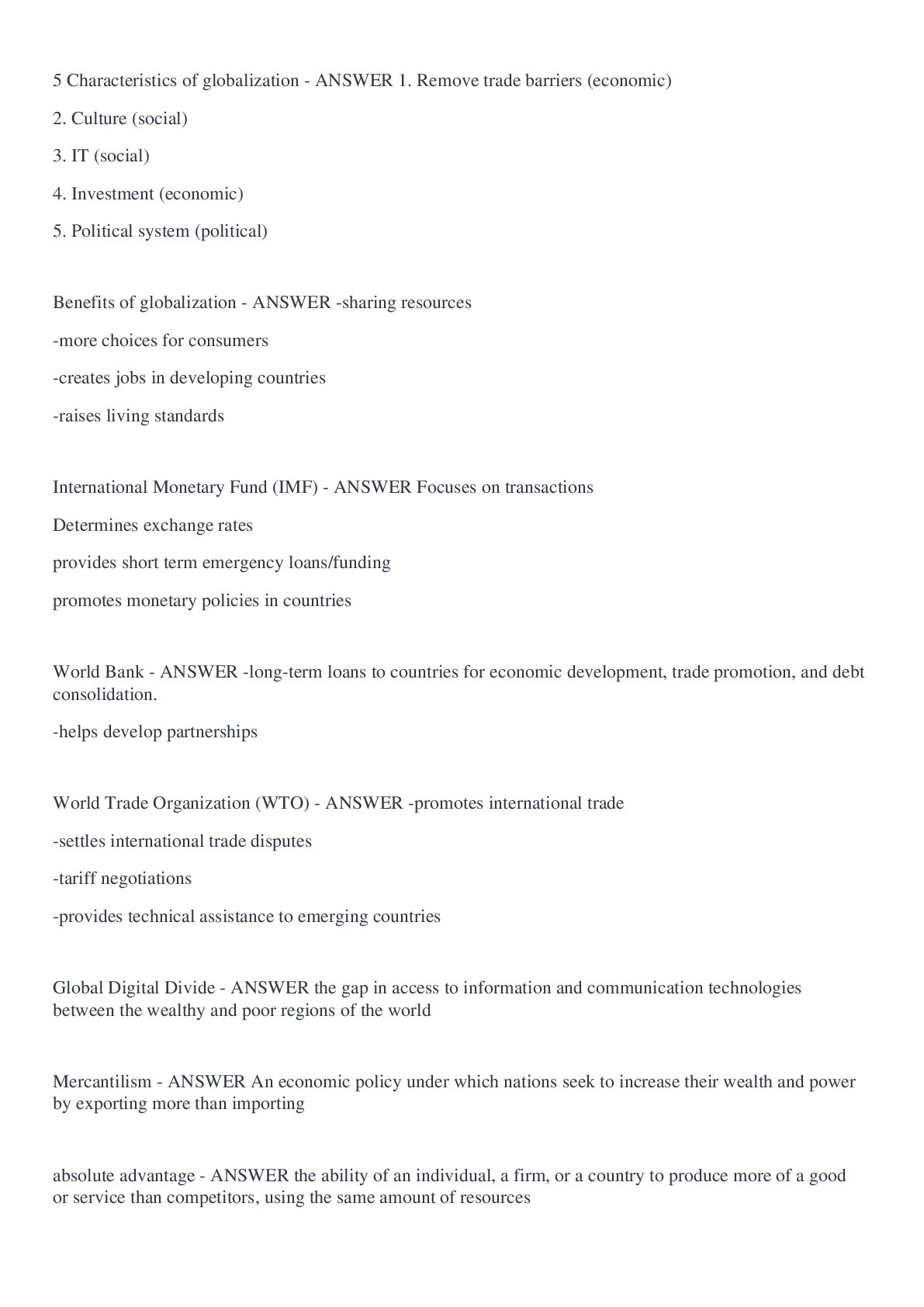
Reviews( 0 )
Document information
Connected school, study & course
About the document
Uploaded On
Aug 06, 2022
Number of pages
12
Written in
Additional information
This document has been written for:
Uploaded
Aug 06, 2022
Downloads
0
Views
51



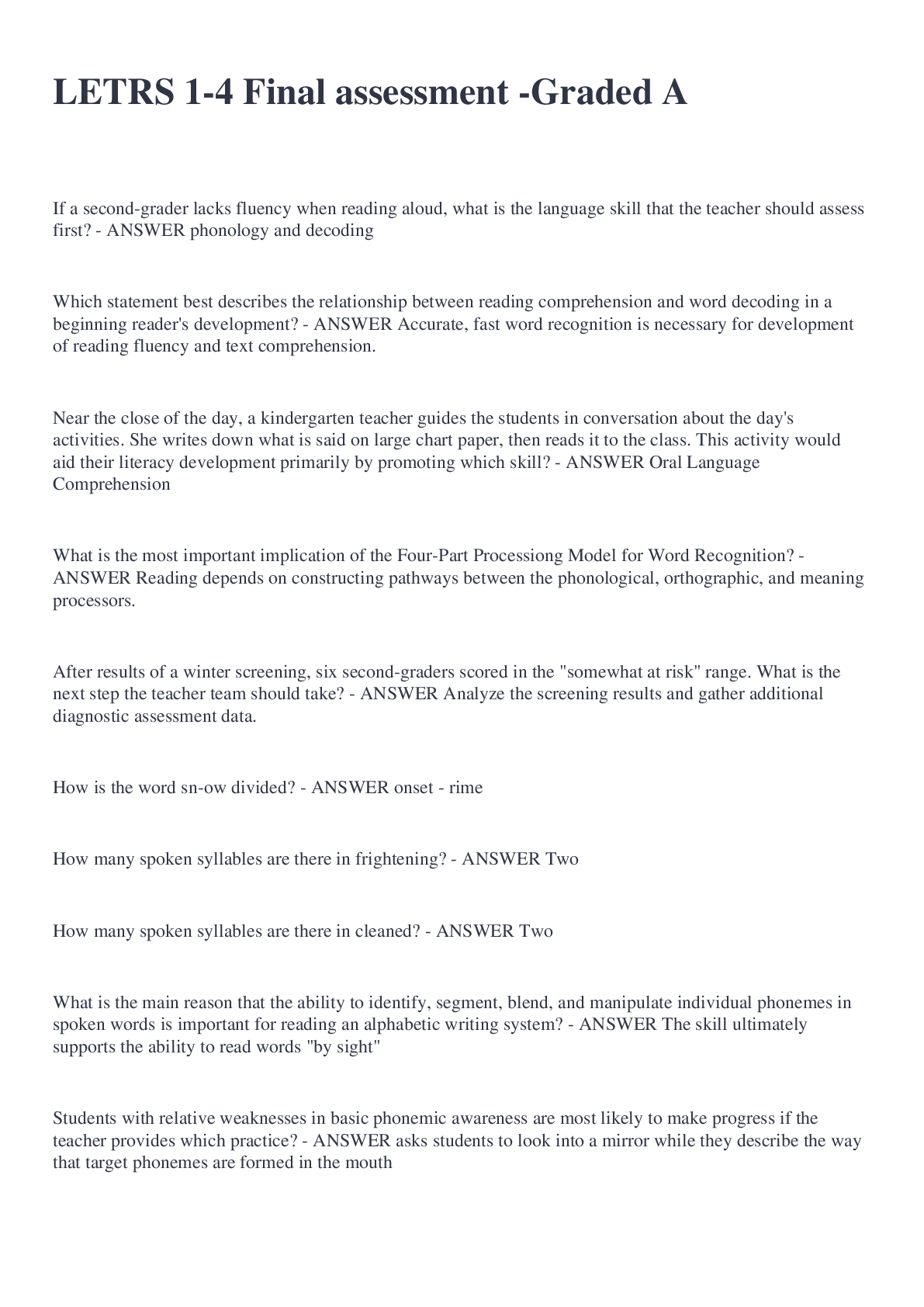


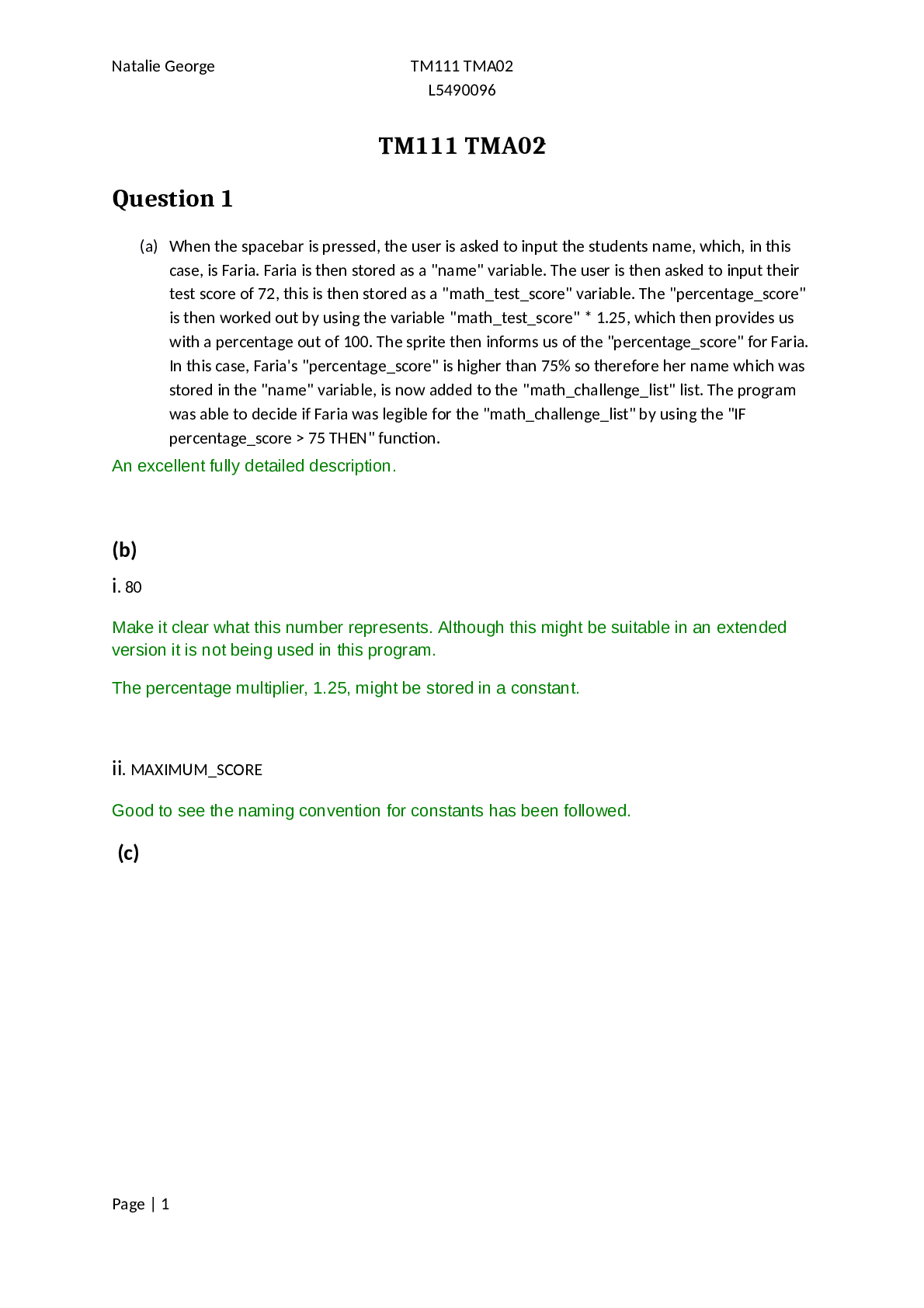


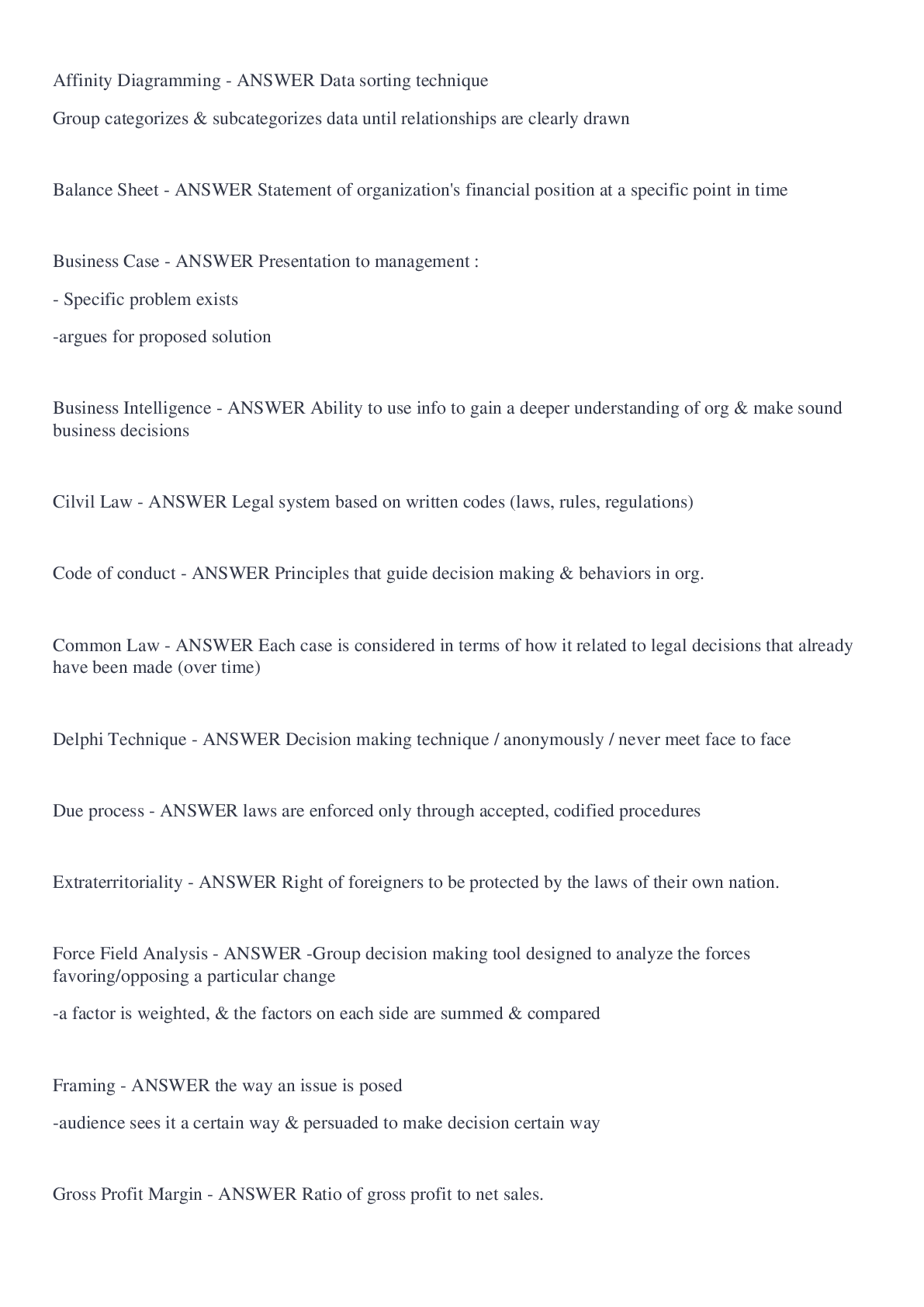

.png)
